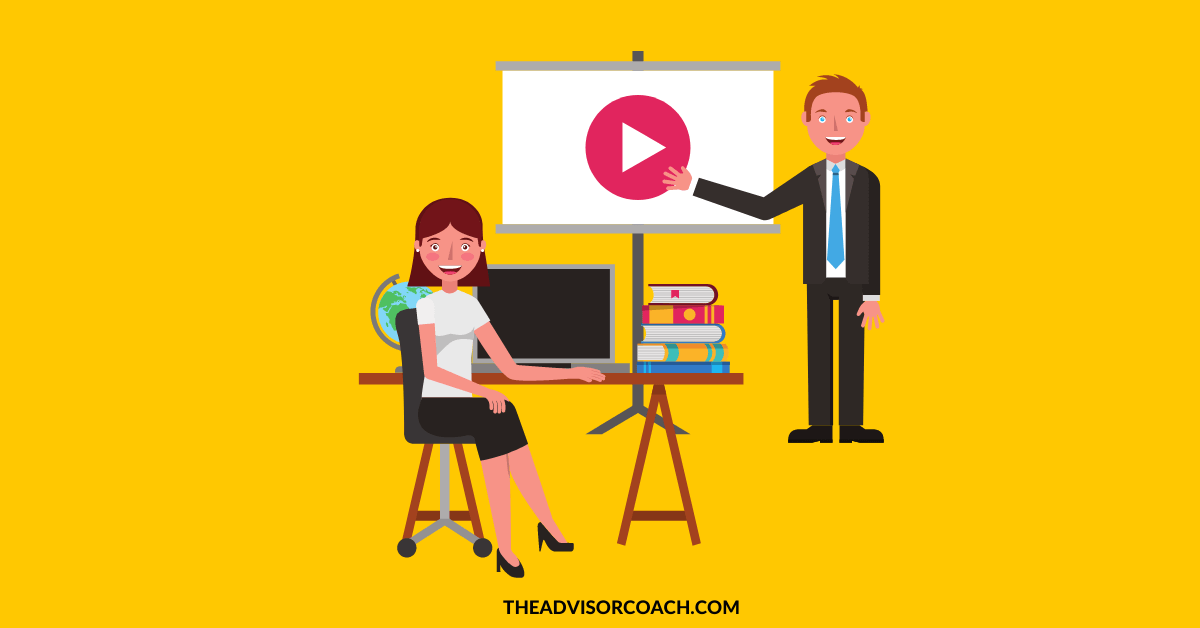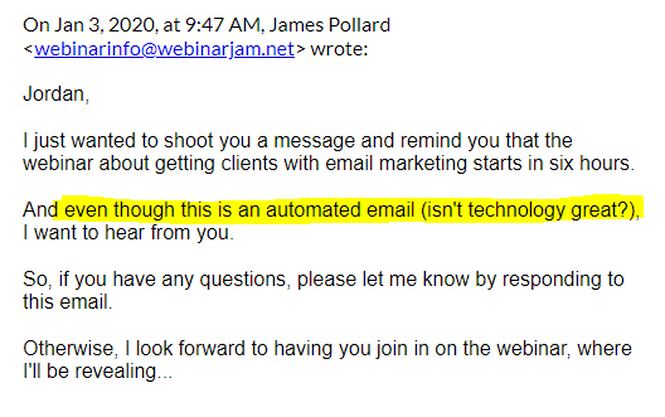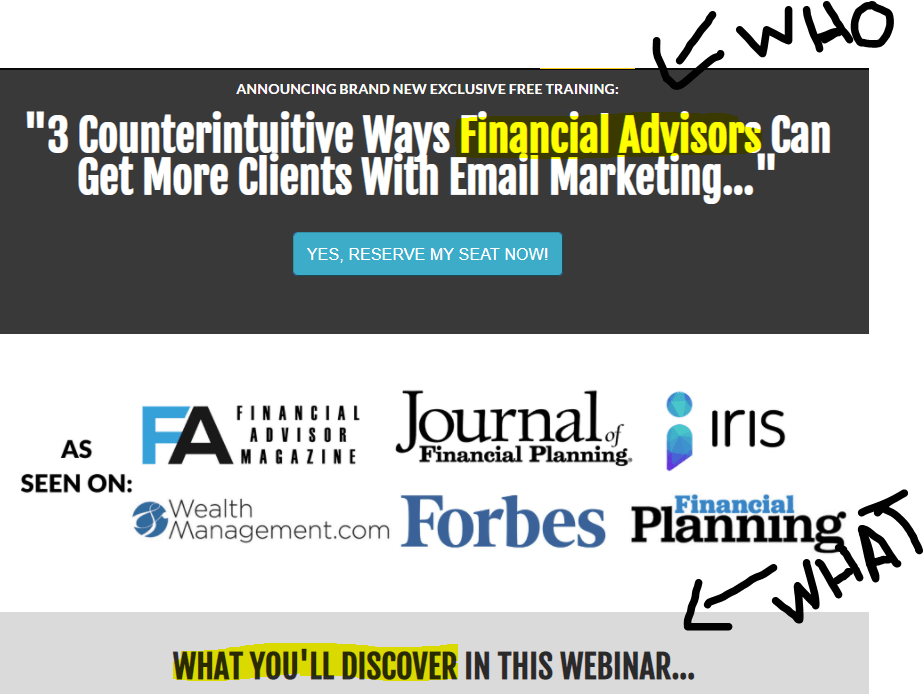3 Powerful Ways Financial Advisors Can Use Webinars To Get More Clients...What if I told you that there was a way to give a presentation to prospects…
Without renting a room at the library… Without spending a small fortune on a “seminar marketing” company… And WITHOUT being physically present? Many years ago, this wasn’t possible. However, today's financial advisors can systematize and scale their businesses using one of the most powerful marketing tools available: the automated webinar. Here's a peek at what we'll cover: Why Webinars?For the purposes of this article, I will talk about automated webinars. Although many of the same concepts apply to live webinars, conducting a live webinar does not offer the same type of systematization and ability to scale as an automated webinar does.
When you automate your online presentation, you remove yourself from the equation and let the webinar do the work for you, whether you’re sleeping, working, or on vacation. Webinars can provide similar benefits to live seminars but without all the costs for the location, food, and other expenses. Even though I will be discussing how financial advisors can use webinars to get more clients, they can also be used to educate existing clients and to keep clients up to date on news and events. ALSO READ: 10 Actionable Seminar Marketing Tips For Financial Advisors Creating Your Webinar ContentThe best advice I can give for creating your webinar content is to make it similar to your live presentation. Create a script or outline if necessary and let compliance scrutinize it. A good rule of thumb is that if you wouldn't say something in person, don't say it during your webinar.
Potential topic ideas include college planning, asset allocation, financial mistakes, budgeting, and so on. If you've had success with seminars in the past, consider taking your live presentation and tweaking it into webinar form. Don't reinvent the wheel. The key to picking a webinar topic is that you want to make it specific to your niche. Using myself as an example, one of my best webinars was called: “3 Counterintuitive Ways Financial Advisors Can Get More Clients With Email Marketing” Because I called out my niche, it means the ONLY people who should register for this webinar are financial advisors. Not only that, but they should also be financial advisors who are interested in getting more clients with email marketing. Your webinar title itself should serve as a filtration mechanism. If you’re someone who specializes in tax planning, I strongly suggest making your webinar topic about tax planning. This seems like simple advice, but I’ve seen financial advisors conduct presentations on budgeting or college planning, only to segue to their “real” specialization. It confuses audiences and leads to poor results. In your actual webinar content, having tons of examples is critical. Again, you want to get everything approved by compliance, so even having 100% hypothetical examples is better than nothing. Too many financial advisors load up their presentations with facts, figures, and boring statistics. Some numbers here and there are okay, but audiences respond more to stories and entertainment. So, when in doubt, add another story. Also, be 100% transparent. If your goal is to have your prospects engage in a financial planning conversation, state that at the beginning. I know this goes against every single “guru” who says to “provide value!” first and then transition into your ask. However, I’ve found that being completely upfront puts audiences at ease. Once they know what’s coming, they can relax and focus on your presentation instead of wondering what’s coming next. If you’ve ever been through my webinars, you know I take my own advice. I start the webinar by telling the audience that, yes, I have something to sell at the end. If they don't like that or don't want to feel “sold” (whatever that means), then they’re free to exit the webinar. But guess what? More people stay when I’m transparent than when I tried to “provide value” and then sell something. Speaking of transparency, never claim your webinar is live if it’s not. I personally go out of my way to let people know the webinar is automated, as shown in my follow-up email below… Again, people are not stupid. They know your marketing is automated. They know you’ve got something to “sell” them. The more transparent you can be, the better.
Finally, for the love of all that is holy, use a high-quality microphone. I don’t necessarily expect you to shell out hundreds of bucks on a mic, but I’ve lost count of how many people try to conduct webinars using their laptop’s built-in microphone or, even worse, their cell phones. I shudder at the thought. Now, here are the “big three” areas you should focus on when designing your webinar… 1. How To Get People To Register...Aside from having a great title and topic, the key to getting people to register for your webinar is to have a well-designed landing page.
I can sum up my best advice for designing webinar landing pages in one word: clarity. A good landing page tells people exactly WHO should attend and WHAT you’re going to talk about. You should also include some information on who you are and why people should listen to you. This doesn't have to be a full-page bio or anything, but it should be enough that people understand a real financial advisor is going to be presenting instead of Joe Blow down the street.
You shouldn’t spend too much time trying to convince or persuade someone to attend the webinar because that work should have been done as you picked your topic. Remember, your webinar topic should immediately appeal to the type of person you’re trying to attract. If you have to hype up your webinar and cajole on your landing page, you’ll inevitably attract lower-quality prospects. However, I’ve found two surefire ways to dramatically increase webinar registrations… The first is offering a “Just-In-Time” webinar. This lets your prospects watch your webinar on-demand, at a time that suits them. They can literally click and attend your webinar almost instantly instead of having to wait days or weeks, by which time most of your registrants won’t attend anyway. Offering a “Just-In-Time” option has boosted attendance literally EVERY time I’ve seen it applied. There have been no exceptions, ever. If you know of any instances where using a “Just-In-Time” webinar has hurt attendance, feel free to write to me and tell me I’m wrong. The next way to increase webinar registrations is to offer a bonus for registering. In my own case, I offer a 25-minute “Email Marketing Q&A” MP3 download when financial advisors register for my webinar. Offering a bonus simply for registering is typically enough to get people to sign up. Notice how this bonus is also niche-specific (because it’s made specifically for financial advisors) and how I’m 100% transparent by saying it’s a “blatant bribe to get you to attend." As far as getting traffic to your landing page, you can promote your webinar using online ads, email marketing, social media marketing, and more. You can even include your registration link in your blog articles and in your email signature.
If you’re a regular listener to the “Financial Advisor Marketing” podcast, you know how much I preach “multiple marketing strategies”. Promoting your webinar across multiple marketing channels is a good example of why this is so important. For example, people may lurk on social media and remain skeptical. However, they may decide to work with you after spending an hour on your webinar. ALSO READ: 7 Easy & Actionable Social Media Marketing Tips For Financial Advisors 2. How To Get People To Attend...According to SmartInsights.com, an average of 36% of registrants attend the event. According to GoToWebinar, marketing webinars (which tend to be done by experienced marketers) have an average attendance rate of 44%. So, if your attendance rate is somewhere in this range, you’re doing just fine.
My attendance rate? 72.9%. So, pay attention and I’ll show you how I do it… Perhaps the biggest mistake people make when they conduct webinars is choosing bad times. Forget all the stats and recommendations out there… what time(s) work for YOUR market? If you’re a financial advisor who specializes in working with teachers, it’s probably a bad idea to run your webinars at 11 a.m. on a Tuesday, no matter what the “experts” say.
Another good way to solve the timing issue is to offer multiple times for prospects to attend. Offering two or three times per day is a good way to do it. Unfortunately, most people only offer their webinars once or twice per week because they want them to seem like they’re live. That’s sneaky, deceptive, and audiences can see right through that. Next, provide some sort of “add to calendar” button or reminder on your thank-you page. I use these buttons all the time, and I must admit that I forget about stuff until I get notifications on my computer. They’ve gotten me to attend several online meetings, webinars, appointments, etc., that I would have otherwise missed. They can provide the same benefit for your webinar. Also, reminders work wonders. Do not be afraid to email your registrants several times to let them know the webinar is coming up. I like to send a reminder a day in advance, six hours before, and fifteen minutes before. Some people might say this is overkill, but I’ve found that people appreciate getting the reminders to make sure they don’t miss it. Besides, I’m not trying to cram “value!” down their throats in every email. I’m being 100% transparent (are you noticing a theme here?) and telling them it’s just an automated reminder. If you want to spruce up your reminder emails a bit, you can create a sense of urgency by recapping what will be covered. Reassure your registrants that they made a good decision. ALSO READ: 5 Financial Advisor Follow-Up Tips (That Won't Annoy Prospects) 3. How To Get People To Stay The Whole Time...Okay, you've gotten people to register... you've even gotten people to attend (woo-hoo!) but now you're faced with one final boss... getting people to stay the whole time.
Your webinar is fighting many distractions: email, text messages, phone calls, and more. Heck, your prospect is literally three clicks away from hilarious cat videos. How can you compete? One of the best ways is to offer something that you give out only at the end. This means someone can't get that particular bonus unless he or she stays for the whole thing. However, some people will just keep your webinar open in another tab and periodically check back for the bonus alone. How can you get them to actually pay attention? In two words: be engaging. This topic could be an entire blog article by itself, but I will try my best to be succinct… I've had the privilege of seeing “behind the scenes” of several successful webinars, and they all have two things in common: they change slides frequently and they use tons of images. This prevents people from getting bored. (I must admit, I am guilty of staying on the same slide for too long, but I try to use an image on every slide.) Another way to be more engaging is to become more excited than you would if you were presenting in person. A long time ago, someone explained to me that if you presented with your “normal” voice in an audio recording or webinar, it would sound flat and monotone. However, if you try to sound extra enthusiastic, it will sound normal in the recording. It sounds strange but, trust me, it’s true. Now, let me give you another example of being transparent: you should let your registrants know exactly how much time they should block off to attend your webinar. You don’t want attendees to think your webinar is going to be 45 minutes, only for it to last an hour because they will begin dropping off around the 45-minute mark. I recommend telling your prospects to block off a slightly larger amount of time than your webinar. This is because you want to give them some time at the end to schedule an appointment with you or complete your desired action. For example, if your webinar is only fifty minutes long, tell registrants to block out an hour in their calendar. ALSO READ: 10 Catastrophic Ways Financial Advisors Sabotage Their Own Success Should You Offer A Replay?Offering a replay is completely up to you. I personally offer a replay because I know that stuff happens. Things come up and people genuinely miss their scheduled webinar time.
However, if you’re not going to offer a replay, make sure you stress that fact on your landing page, on your thank you page and in your reminder emails leading up to the webinar. People are somewhat used to presenters offering replays at the end of a webinar so registrants will operate under that assumption unless you tell them otherwise. Offering a webinar replay has its advantages and disadvantages, and whether or not to offer one depends largely on your business model, audience, and goals. Here’s an expanded look at the pros and cons: Pros of Offering a Webinar Replay:
Cons of Offering a Webinar Replay:
Strategies for Offering a Webinar Replay: If you decide to offer a replay, consider these strategies to mitigate some of the cons:
By carefully considering these pros and cons and implementing strategies that align with your objectives, you can make the most out of offering a webinar replay and ensure it serves your marketing and educational goals effectively. The "Stealth" Benefit Of Automated WebinarsPerhaps the biggest side benefit to conducting automated webinars is that they build your email list. This means that even if someone doesn’t even watch your webinar, you can continue communicating with that person through your email list.
If you don’t have a separate lead magnet or opt-in form to build your email list, you can use your webinar. Because if someone doesn’t set an appointment with you as a result of the webinar itself, you can continue to build the relationship through email until it happens. Certainly, expanding on the benefits of using automated webinars for email list building can provide a clearer understanding of this strategy. Here's a more detailed explanation: Enhanced Lead Generation and List Building: Automated webinars are powerful tools for lead generation. When participants register for your webinar, they provide their email addresses, which adds them to your email list. This process converts interested individuals into leads without the need for additional lead magnets or opt-in forms. Continuous Engagement and Nurturing: Even if registrants don't attend the webinar or leave early, having their contact information allows you to continue the conversation. You can send follow-up emails with key takeaways from the webinar, additional resources, or exclusive offers. This continuous engagement helps in nurturing leads and moving them further along the sales funnel. Segmentation and Personalization: You can segment your email list based on the actions participants took regarding the webinar. For example, you can create different follow-up sequences for those who attended the entire webinar, those who left early, and those who registered but didn't attend. This segmentation allows for personalized communication, increasing the relevance and effectiveness of your emails. Long-Term Relationship Building: Through regular email communication, you can build a relationship with your leads over time. Share valuable content, industry insights, and helpful advice to establish yourself as a trusted authority. This relationship-building sets the foundation for converting leads into clients when they're ready. Feedback and Improvement: Use your email communications to solicit feedback about the webinar. Understanding what participants found valuable or lacking can help you improve future webinars and other marketing materials. Additionally, engaging with your audience through surveys or reply requests can enhance their sense of involvement and loyalty. Cross-Promotion Opportunities: Your email list provides a platform to promote other services, products, or upcoming webinars. By delivering consistent value, you increase the likelihood that subscribers will take advantage of other offers, participate in future events, or set appointments for consultations. Cost-Effectiveness: Compared to other lead generation strategies, automated webinars combined with email marketing can be highly cost-effective. Once the webinar is created, it can be used repeatedly to capture new leads and nurture them through automated email sequences, resulting in a scalable system that operates without the need for constant oversight. In summary, using automated webinars as a tool for building and nurturing an email list is a strategic approach that can lead to more engaged leads, improved sales conversions, and long-term client relationships. By providing value through both the webinar and subsequent email communications, financial advisors can effectively grow their client base and establish a strong online presence. About The Author...
Hey, I'm James Pollard. I'm the guy behind this website.
I've dedicated my career to empowering financial advisors to unlock their full potential. With a passion for marketing and a knack for cutting through the noise, I provide actionable strategies and insights that help financial advisors build better businesses. I'm also the host of the popular Financial Advisor Marketing podcast. Beyond the mic, I'm constantly sharing my expertise through The James Pollard Inner Circle™ newsletter, which has grown to become one of the most successful communities in the financial advice space. Thanks for stopping by and diving into my world. If you'd like to connect with me on LinkedIn, here is where you can find me. |







